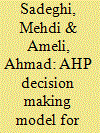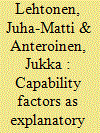|
|
|
Sort Order |
|
|
|
Items / Page
|
|
|
|
|
|
|
| Srl | Item |
| 1 |
ID:
113414


|
|
|
|
|
| Publication |
2012.
|
| Summary/Abstract |
This paper presents an analytical hierarchy process (AHP) decision model for sectoral allocation of energy subsidy based on several criteria. With determination of priorities for these criteria through questionnaire and AHP method, the overall rank of these criteria that have the most influence on distribution of energy subsidy among socio-economic sub-sectors, are as the following: inflation, economic growth, labor intensity, distribution of energy subsidy among socio-economic levels, energy intensity and social cost of air pollution. According to the model, the first priority for allocation of energy subsidy is commercial sector and the last priority is related to transportation sector. Investigating the impact of changing priority of the criteria on overall results indicates that the socio-economic sub sectors' ranking in receiving subsidy have little sensitivity for changing priority of the subsidy criteria.
|
|
|
|
|
|
|
|
|
|
|
|
|
|
|
|
| 2 |
ID:
144157


|
|
|
|
|
| Summary/Abstract |
In clarifying the conceptual and terminological issues of the unit cost growth of military equipment, six recent empirical studies on unit cost growth are reviewed and evaluated in this article. Even though the reported unit cost growth rates differ between equipment type and the individual studies, all of the studies find the unit cost growth rates of each military equipment type exceeding inflation. Various explanations proposed by different authors are reviewed. Unit cost growth studies omit corrections for quality changes of equipment, unlike the standard practice in inflation calculation. By bringing the military capability perspective into the discussion of unit cost growth, this article proposes a new approach to equipment unit cost growth, thereby enabling the collective evaluation of quality change with price change. This approach is demonstrated through a case study involving an armoured personnel carrier (APC). Although the price of the APC had increased sixfold with only a minor improvement in transportation capability, the proposed approach shows that the purchasing decisions of its successive generations may have still been cost-effective. The APC case demonstrated that the proposed approach can be successfully applied and yield meaningful results.
|
|
|
|
|
|
|
|
|
|
|
|
|
|
|
|
| 3 |
ID:
092856


|
|
|
|
|
| Publication |
2009.
|
| Summary/Abstract |
The purpose of this paper is to present an assessment and evaluation model for the prioritization of distributed generation (DG) technologies, both conventional and renewable, to meet the increasing load due to the growth rate in Iran, while considering the issue of sustainable development. The proposed hierarchical decision making strategy is presented from the viewpoint of either the distribution company (DisCo) or the independent power producer (IPP) as a private entity. Nowadays, DG is a broadly-used term that covers various technologies; however, it is difficult to find a unique DG technology that takes into account multiple considerations, such as economic, technical, and environmental attributes. For this purpose, a multi-attribute decision making (MADM) approach is used to assess the alternatives for DG technology with respect to their economic, technical and environmental attributes. In addition, a regional primary energy attribute is also included in the hierarchy to express the potential of various kinds of energy resources in the regions under study. The obtained priority of DG technologies help decision maker in each region how allocate their total investment budget to the various technologies. From the performed analysis, it is observed that gas turbines are almost the best technologies for investing in various regions of Iran. At the end of the decision making process, a sensitivity analysis is performed based on the state regulations to indicate how the variations of the attributes' weights influence the DG alternatives' priority. This proposed analytical framework is implemented in seven parts of Iran with different climatic conditions and energy resources.
|
|
|
|
|
|
|
|
|
|
|
|
|
|
|
|
|
|
|
|
|